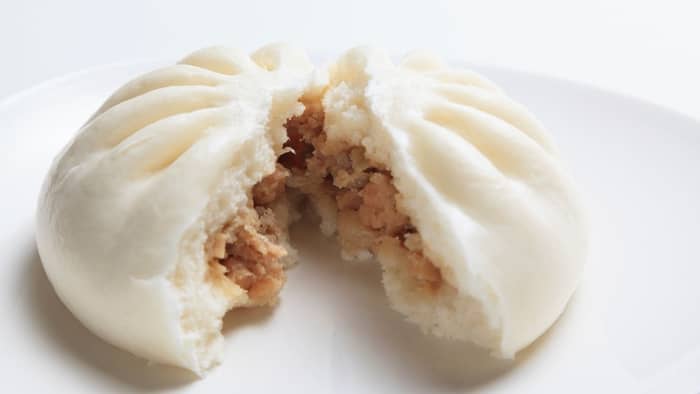Last Updated on September 14, 2021
Today, we’re going to be looking at Japanese meat bun recipes. You may know them better as nikuman, bao, or baozi. Asian cooking is becoming increasingly popular in the Western world, and it’s not hard to see why. There are so many delicious dishes that are on offer, and Japanese meat buns are definitely one of them. But are they gluten-free? What recipes can you follow? Let’s take a look.
What Is Nikuman?
Usually filled with pork, and then vegetables such as mushroom, cabbage, and scallions, it’s a very popular dish. It can of course have a filling of your choice, but more traditionally, it’s pork. The buns are soft and fluffy after being steamed; these buns are a leavened type of bread.
The buns are usually made with flour dough and then a filling of choice. They’re savory, juicy, and often sold in the winter months in convenience stores in Japan. I wish our convenience stores sold such mouthwatering snacks!

Learn more about: Are Yakisoba Noodles Gluten Free?
Popular Bao Bun Fillings
Pork is no doubt the most popular, but there are a huge selection of fillings you may come across in your bao buns. Here’s just a few:
- Beef Bao Buns
- Fish Bao Buns
- BBQ Pork Bao Buns
- Mushrooms Bao Buns
- Vegetable Bao Buns
- Chocolate Bao Buns (dessert and bread – uhm, yum! Is there really a better combination?)
Is It Gluten-Free?
Traditionally, no. If you walk into a store or go somewhere that’s serving Japanese steamed buns, it likely won’t be gluten-free. This is because of the ingredients. The ingredients for the buns are as follows:
- plain flour
- sugar
- salt
- baking powder
- yeast
- oil
- water
Now, I’m sure you can see the red flag among those ingredients. The flour, of course. That’s right, the main ingredient contains wheat. The filling itself is usually gluten-free, as it’s just meat and vegetables. But the buns themselves most certainly are not gluten-free. Also, for the fillings, you may need to watch out for soy sauce. Some soy sauce is not gluten-free.
This is because these ingredients contain a gluten-containing grain (barley, rye, wheat, etc.). These grains can not be safely eaten when following a gluten-free diet.
Recipes
I’ll be honest, there isn’t exactly a large selection of gluten-free bao buns on offer. Even without the filling (which is easy enough to make yourself), the options are very sparse if you’re looking to fulfill that craving. That’s why it may be more successful to try making your own.
Glutafin is a popular brand within the UK and their website has a whole range of recipes. One of them being Gluten-Free Bao Buns with Pulled Pork. Pulled pork is one of my all-time favorite fillings – is it just me who loves it in burgers?! For the bao buns themselves, there’s not that many ingredients at all! The ingredients are:
- Gluten-Free Multipurpose Flour
- Sugar
- Milk
- Sunflower Oil
- Salt
- Warm Water
- Baking Powder
- Rice Vinegar
I’m sure you already have a lot of those products just sitting waiting in your pantry! The filling isn’t too important as you really can include whatever you’re craving that day.
I thought it might be worth mentioning that if you’re in the UK, you can apply for a free taster box from Glutafin, which is perfect if your diagnosis is new. You can check your eligibility on their website.
Shop Bought
As I mentioned earlier, it’s almost impossible to source gluten-free bao buns online! I was able to find two options, one of which is a company I’ve tried before.
Gluten-Free Bao Buns (Buns Only)
The first option is ready-made gluten-free bao buns by Gron Haus. They’re not just certified gluten-free. They’re also dairy-free, egg-free, low FODMAP, low sugar, and vegan. This makes them ideal for a range of dietary lifestyles. You can find them here. They come frozen and the main ingredients are as follows:
“Corn Starch, Rice Flour, Thickeners (Modified Tapioca Starch, Hydroxypropyl Methylcellulose), Raising Agents, Sugar, Psyllium Husk, Palm Fat, Iodized Sea Salt, Vegetable Emulsifier (Mono and Diglycerides of Fatty Acids, Yeast, Water, Coconut Oil, Canola Oil”
These can be steamed for 5 minutes or ready in the microwave in 30 seconds.

Ready-Made Bao Buns
This is a company I’ve tried before and it’s been very hit and miss. Some of their food has been incredible and made me go back to re-order. But other times, the food has been disappointing and is easy to identify that the food is gluten-free, which is not what I look for. However, I’m yet to try their bao buns, but it’s definitely something I’ll be doing soon.
Good, It’s Gluten-Free Bao Buns come pre-made. All that needs to be done is some warming up! The buns come in 4 mouthwatering flavors:
- Korean Popcorn
- Chicken Katsu
- Char Sui Pork
- Hoisin Mushroom (vegan)
Each pack contains 3 buns, the fillings, the toppings and costs £6.99. For ready-prepared food, I think that’s reasonably inexpensive. And for something that’s so rare in the gluten-free community, I definitely think it’s worth trying. They certainly look delicious!

Conclusion
I hope this article has helped you become familiar with some gluten-free Japanese meat bun recipes. While there may not be that much choice at the moment, in terms of gluten-free bao buns, hopefully in the future that will change. The gluten-free food market seems to be growing by the day, so fingers crossed for the future.
I think I may be making an order with Good, it’s Gluten-Free now. I’ll report back with how those Bao Buns taste soon!
Do you have any gluten-free bao bun recipes? The easier the better – I’m such a novice in the kitchen! If you do, please feel free to leave them in the comments below and share with the rest of the gluten-free community. Sharing is caring!

Hi, my name’s Zoë. I’m 28 years old and live in London, UK. I work full time as a freelance writer and critic for West End theatre. Writing has been a passion of mine for as long as I can remember. I spend most of my free time at the theatre, or at conventions. I’m married to the love of my life, and live in a small apartment with my fur baby, Lillie. I run two of my own blogs: No Safer Place and Stage to Page: both of which have won awards. I also have a YouTube channel where I talk about all things stagey.
